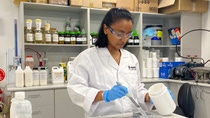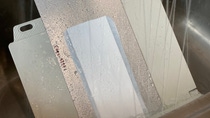Innovating architectural coatings: New polymer dispersion helps paint withstand early rain

Architectural exterior coatings work hard all year round, especially across Australia where the weather can be extremely volatile. Parts of the country can experience extreme summer heat exceeding 40 degrees, while other areas experience high rainfall, snow and frost.
Throughout all these external factors, coatings need to hold their colour, structure and flexibility from the first application. As the professional painters’ market aims to continue to meet the durability standards for architectural exterior coatings, formulators are working to create products that hold up in changing weather conditions.
Winter can be a particularly challenging time, bringing temperature swings that can strain coatings and the substrates underneath. Winter brings more pronounced temperature drops at night, which causes the substrate to contract under the coating. When the sun comes up again, rising temperatures cause expansion. Whether the substrate is wood, metal, vinyl, masonry or fiber cement, the coating needs to keep up with its movements to avoid cracking.
One of the key characteristics for a winter-proof coating is grain crack resistance, which measures the coating’s ability to withstand substrate movement without cracking.
BASF’s Acronal® EDGE 4247 is a high performance, all-acrylic latex designed for exterior flat to semi-gloss paints. This ultra-low VOC capable latex (<25 g/l) provides the foundation for premium performance by delivering outstanding primer and top coat attributes. Superior top-coat durability is attained due to its superior dirt pick-up resistance, surfactant leaching resistance and grain cracking resistance. This enables it to withstand the most challenging temperature and humidity fluctuations.
In Australia, Acronal EDGE 4247 has been undergoing testing for multi-weather suitability at BASF’s Laboratory in Clayton, Victoria. The problem of rain has been a focus during testing, to support paint application in areas that experience heavy rainfall. “Throughout the different testing methods, we realised Acronal EDGE 4247 showed stand-out early rain resistance to the commercial standards without compromising the open time,” said Shehani Nanayakkara, Technical Services Chemist at BASF. “We have done a lot of testing to imitate a vast range of local weather conditions. One of the most impressive results was the level of wash proof it experienced while replicating high humidity with heavy rainfall shortly after application,” explained Shehani. “In tinted systems there are other additives which can worsen the properties of your base paint. What we see with this polymer is that even in a tinted system it retains good early rain resistance”.
Having a local lab at Monash University, BASF can undertake the testing of global innovations for Australian conditions, providing direct and immediate support for local customers.
In addition to these benefits, Acronal EDGE 4247 also has optimisation of titanium dioxide which offers savings of up to 10%. This reduces costs and reliance on natural resources, helping make it a more sustainable choice for product formulation. Acronal EDGE 4247, an acrylic latex resin, is engineered to handle low temperature application without compromising on other important performance attributes which helps to solve the winter challenges experienced by contract painters.
Acronal EDGE 4247 launched at the American Coatings Show in 2018 and is expected to receive registration in Australia late 2020. For more information, please contact your BASF sales representative.
